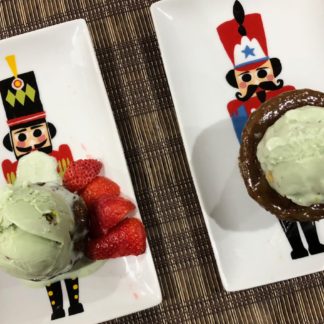
Temple Pongal Lentil Rice is the prasad one gets when one visits South Indian temples. The most famous south Indian temple is the Tirupati Balaji Temple in Andhra Pradesh. The temple is situated atop a hill and surrounded by seven hills around it. The access to the temple from the base of the city is a long winding road, and using the stairs/trails to hike up can take about 3-4 hours on foot. This is the most wealthiest of temples in India, with devotees giving large contribution as donations. This temple was what I visited post my marriage and coming from Jain household, was struck by the beauty, discipline and the utmost devotion expressed at various levels, from the learned priests to the the person working in the guesthouses over there. The temple prasad was just true delicacy, and having had my first taste of pongal as Tirupati Pongal, I am kind of spoiled by that. A lot of restaurants serve this Pongal as Ven Pongal or Khara Pongal, but not many come close to the color, texture and taste of the original Tirupati Pongal. So on this day of Pongal, I took the time to recreate what I remembered from my visit many many years ago and hope Lord Balaji is blessing me on this attempt!
The texture of Temple Pongal Lentil Rice as I remember was more like porridge, and made out of small grain rice. And I recollect the color as white base, and the taste of raw cumin and the yellow moong dal being seen clearly and of course dollops of ghee, cashews and black pepper! A lot of recipes on the web talk about adding curry leaves. ginger and turmeric. However, I decided against it as that does not match with my visual memory. I could be wrong, but still wanted to make an attempt to recreate the blessings I received via the temple pongal in the way I remembered. And besides the logic that makes sense, is that this prasad would be made as simple as possible, considering the vast number of devotees that visit the temple. And the logistics of carrying curry leaves, ginger all way atop a hill and then the labor involved in cleaning and cutting would be a bit too much. Not using the added ingredients also helps me keep this recipe suitable to the aatham/chaudas menu, when green and root vegetables are not consumed in the menu. There are some Jains who believe that the temple idol of Lord Balaji at Tirupati was originally an idol of Shri NeminathTirthankar. Whatever be the belief, the fact that today it is the most wealthiest temple and the most revered by devotees speaks volume for the faith of the devotee as well as the blessings obtained at the Tirupati Balaji Temple.
The Temple Pongal Lentil Rice is often cited as a complete meal as it has its content of grain, lentil and lots of protein via ghee and nutrition of cashews and black pepper. Black pepper was the original spice from India, used in place of red and green chillies. Pongal, festival of harvest in Tamil Nadu, is often celebrated by boiling milk over and Pongal also means boiling over.
Wishing all of you a Very Happy Pongal and loads of good wishes as you start a new year with optimism and good thoughts with the prasad of Temple Pongal Lentil Rice and blessings of Lord Balaji to guide you through the year!
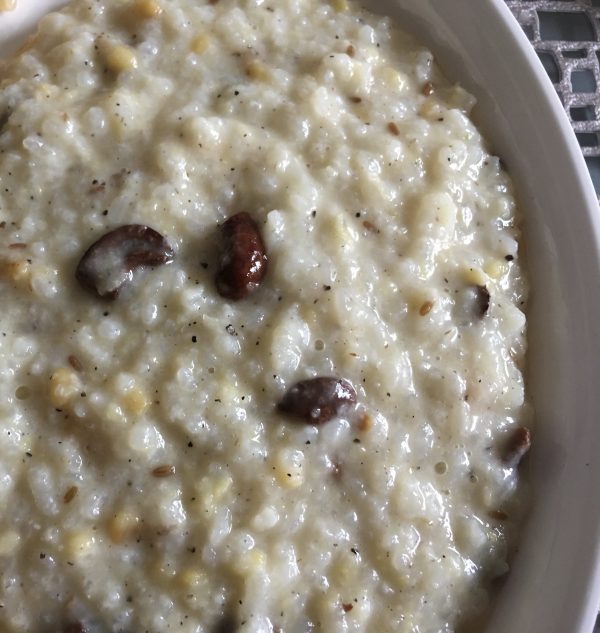
| Prep Time | 5 minutes |
| Cook Time | 30 minutes |
| Passive Time | 30 minutes |
| Servings |
people
|
- 1 cups Small grain Rice Goya Brand Spanish Rice is what I used, or Sona Masoori is more common
- 1/2 cup Yellow Split Green Lentil Yellow Moong Dal
- 2 tsp crushed black pepper
- 5-6 whole black peppercorns optional
- 1 tsp cumin seeds crushed in palm
- salt to taste
- 3 tbsp Ghee unmelted
- 2 tbsp cashew pieces
- 1/2 cup low fat milk
- 1/4 tsp asafetida powder
Ingredients
|

|
- Dry roast the yellow moong dal in a pan for 2-3 minutes on low flame till you get the aroma of roasting,
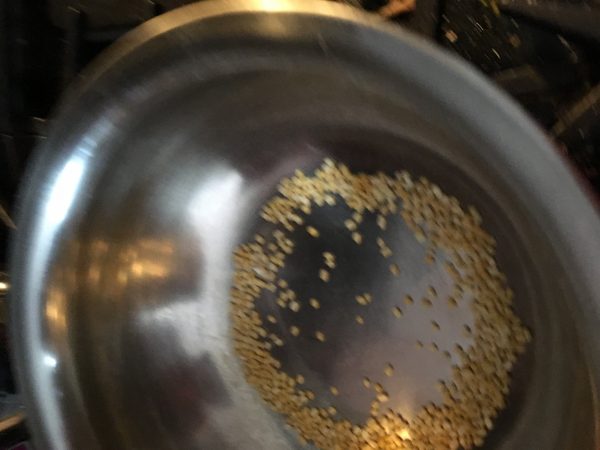
- Wash the rice thrice and soak with five and half cups of water for 30 minutes. After soaking, boil this soaked rice, along with its water. Add salt, peppercorns, cumin seeds and milk to it.
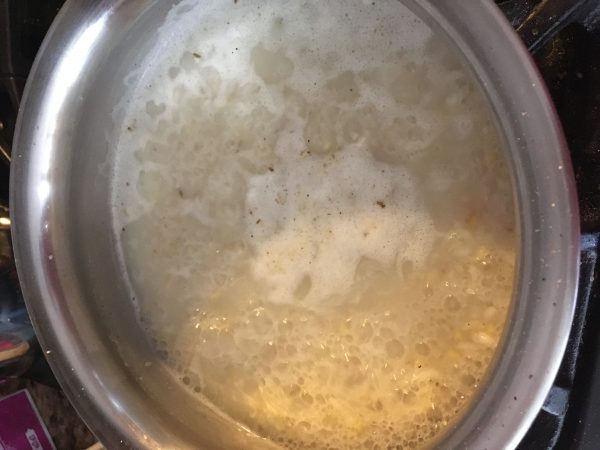
- Keep stirring in between so that the rice does not stick at the bottom. Halfway through add the roasted yellow moong dal.
- Once the rice and dal are cooked, and you have reached the desired consistency of the pongal, remove from flame. If the consistency looks to soupy, keep cooking till water is reduced.
- Heat the ghee in a small vessel, and add cashews and stir till they are golden brown. Add asafetida and remove from flame. Add this to the rice and mix well, and cook rice for another 2-3 minutes for the flavor to set in.
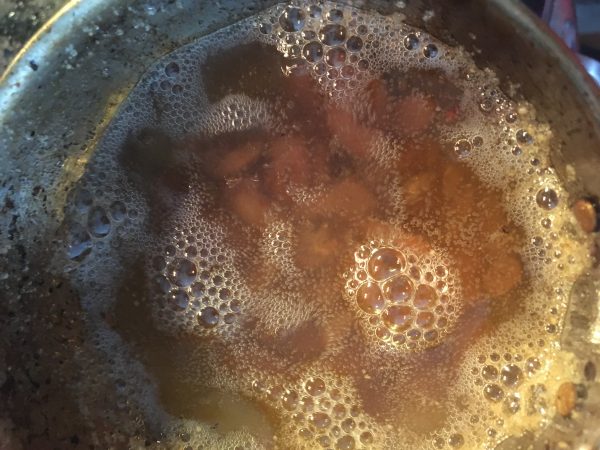
- Add the crushed pepper powder and keep stirring whole time, so that the rice does not set at the bottom.
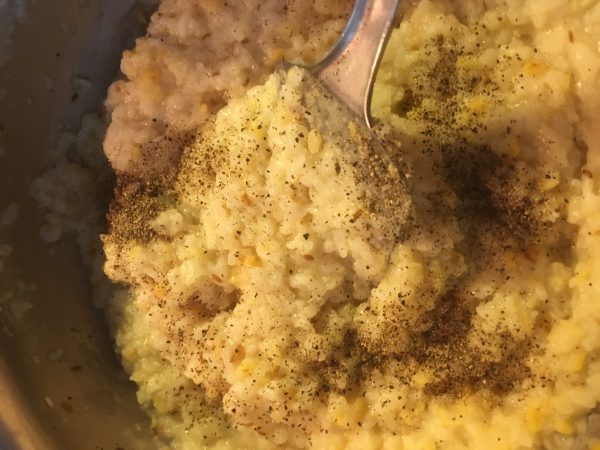
- Serve warm with Shakkar Pongal or with coconut chutney or pickle or just plain is also very delicious!!. Plain yogurt serves a good accompaniment to Temple Pongal.
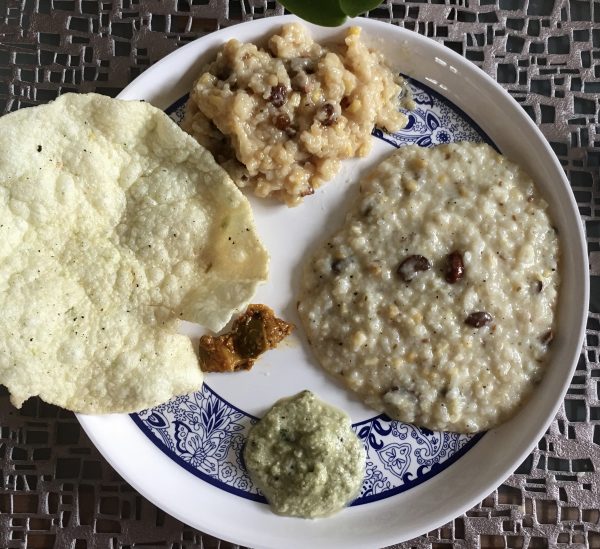
Tips
- Small grain rice are crucial to obtaining the texture of the pongal as well as cooking on the stove is important so that you can get the right texture. I used the Spanish Goya Rice as thats what I had at home and it worked well.
- Ensure that the cashews do not get burned, and stay golden, which I missed out on.
Instinct Factor
- Quite a bit of instinct involved in recreating this recipe by memory. I could be wrong, but I hope my readers from southern India will forgive me:) Feel free to add red chillies, some coriander, if you want to add some more spice and fragrance.
Feel Factor
Happy to have the prasad of Lord Balaji and invoke his blessings in some way! Texture was great according to my husband, who just loves this Pongal and any Pongal on earth. So much so that the Pongal restaurant in New York City, is his Mecca for this and we have to make a visit every time we are in NYC. So a compliment from him made my effort worthwhile.. Loved the cumin, black pepper and ghee flavor in this traditional temple recipe of pongal.
[contact-form-7 404 "Not Found"]

